The Blueprint for Manufacturing Communication Success
Proven Strategies for Building Connection, Driving Engagement, and Delivering Results

Blueprint overview: A new approach to manufacturing communication
The manufacturing industry is at a turning point. Rapid digital transformation, an aging workforce, and increasing demands for efficiency, safety, and sustainability have placed unprecedented pressure on organizations. Yet, amid these challenges, internal communication in manufacturing remains an untapped resource — a critical lever that can connect workers, improve engagement, and drive measurable business results.
This playbook equips manufacturing leaders and communicators to drive success by empowering leadership and managers to deliver clear, consistent messaging that supports upskilling and automation adoption. It ensures workers feel valued and connected to your organization’s goals, addressing labor shortages and attracting younger talent.
With mobile-first communication strategies, you can reach every employee, bridging gaps and supporting frontline workers. It also helps navigate safety risks and disruptions with reliable tools that ensure business continuity and employee well-being, while focusing on the impact of communication to build understanding, trust, and alignment.
What this blueprint delivers
This playbook is your ultimate guide to building effective communication in manufacturing, offering a combination of practical resources, real-world examples, and actionable strategies designed to deliver measurable results.
Practical Tools: Audience mapping/segmenting templates, and communication calendars to guide implementation.
Real-World Insights: Case studies and examples from industry leaders who have overcome similar challenges.
Actionable Steps: Simple, clear guidance to improve communication at every level — from onboarding to leadership visibility to crisis preparedness.
Measurable Outcomes: A focus on achieving real results — like reduced turnover, improved safety, and stronger employee advocacy — by connecting communication to business goals.
Quick Wins: Immediate, practical actions to tackle pressing communication challenges and create momentum while laying the foundation for lasting success.
Your path to success
By adopting this communication blueprint, you will:
Build a connected workforce where every employee has access to the information they need, when they need it.
Foster an engaged culture where workers feel valued, supported, and aligned with your mission.
Create inspired advocates who trust your leadership, take pride in their roles, and champion your brand from the inside out.
Manufacturing success starts with a workforce that is connected, engaged, and inspired. This playbook gives you the blueprint to make that goal a reality — one step at a time.
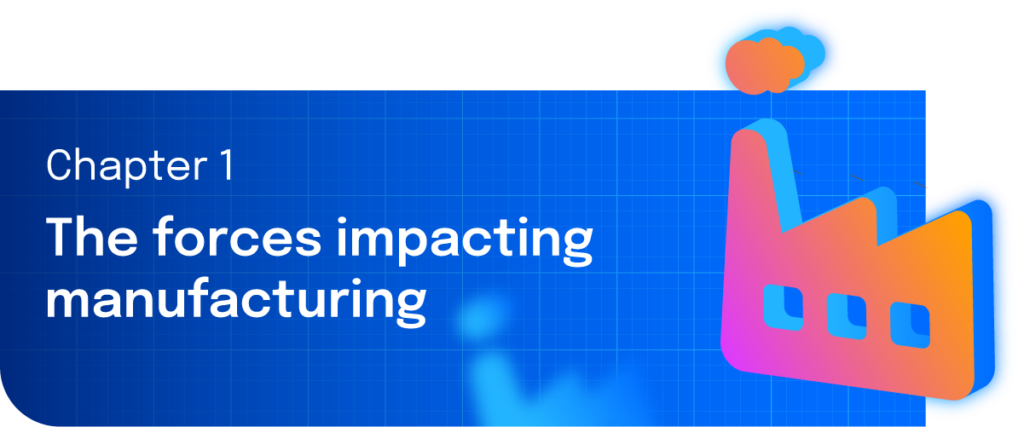
The manufacturing industry is undergoing a seismic shift. From factory floors to boardrooms, leaders are navigating a landscape shaped by rapid technological advances, workforce challenges, and an increasingly uncertain world. Automation, artificial intelligence, and the digitalization of production processes are transforming how work is done, demanding a skilled workforce capable of operating in this new environment.
According to the World Economic Forum, 40% of current skill requirements in advanced manufacturing will change within the next five years. While this transformation promises greater efficiency and innovation, it brings significant disruption: workers need to be upskilled, resistance to change must be overcome, and leaders must ensure everyone — from the control room to the production line — understands their role in the bigger picture.
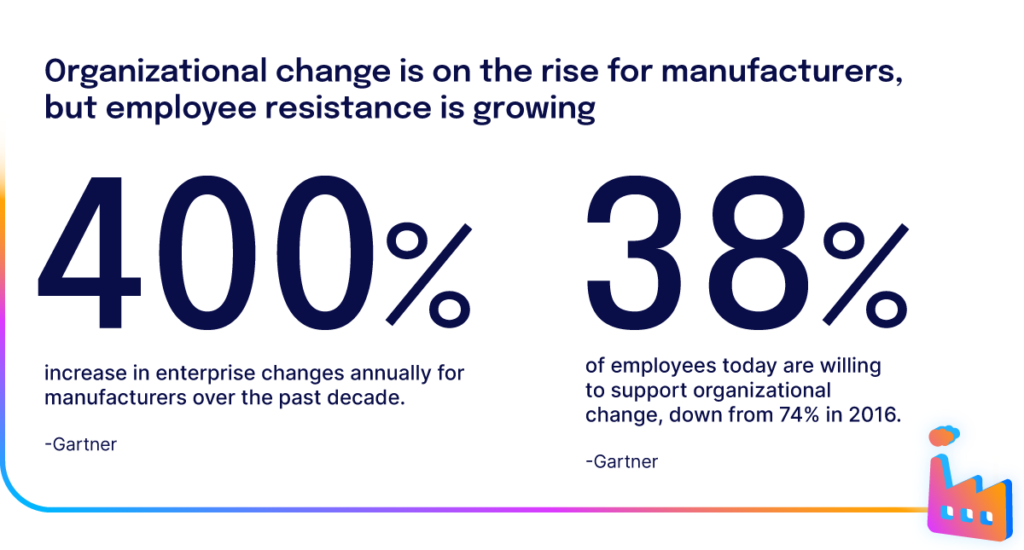
Sources: “Leadership Vision for 2025: Top 3 Strategic Priorities for Chief HR Officers,” Gartner, accessed January 17, 2025. Jordan Turner, “This New Strategy Could Be Your Ticket to Change Management Success,” Gartner, November 28, 2022.
The challenge isn’t just technical; it’s human. Outdated communication systems fail to reach frontline workers, erode trust, and create disconnect across the business. So, how do you ensure employees don’t feel left behind as machines move forward?
The workforce crisis: Aging employees and talent gaps
Manufacturers are also battling a growing talent crisis. Walk onto any factory floor, and you’ll notice a trend: the workforce is aging. Globally, one-third of manufacturing workers are over 55 years old. As skilled workers retire, they leave behind not only decades of knowledge and expertise but also a physical gap in the workforce, creating vacancies that are critical to maintaining operations and productivity.
In countries like the United States, Germany, the United Kingdom, Australia, and Japan, the number of unfilled manufacturing roles is staggering, leaving factories struggling to find the people needed to keep machines running, meet production targets, and sustain growth.
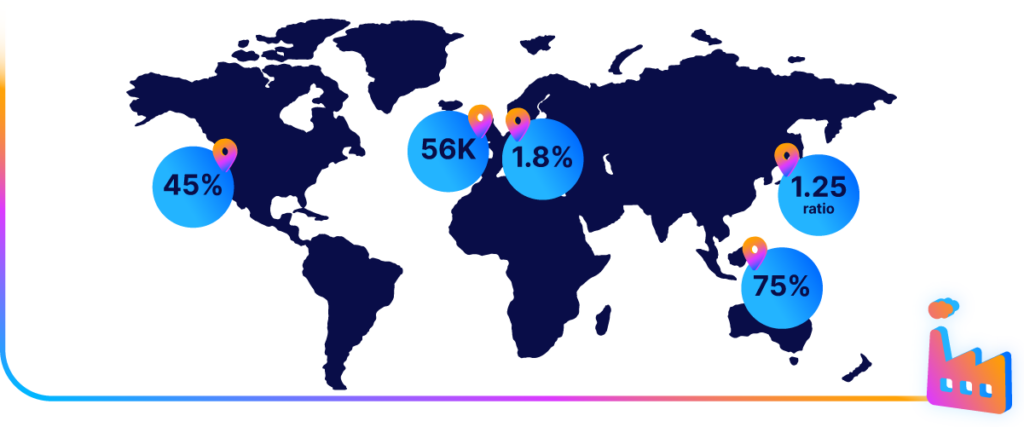 Across the globe, ongoing challenges filling manufacturing positions are impacting production capacities and profitability.
Across the globe, ongoing challenges filling manufacturing positions are impacting production capacities and profitability.
United States: Approximately 45% of all job openings remain unfilled, with labor shortages in manufacturing reducing production capacity and threatening company profitability.
Asia-Pacific (APAC): 75% of manufacturing businesses are experiencing a skills shortage, particularly in technical trades and machinery operation.
United Kingdom: As of September 2024, there were approximately 56,000 job vacancies in the manufacturing sector.
Germany: The job vacancy rate in the manufacturing sector is 1.8%.
Japan: In October 2024, the active job openings-to-applicants ratio was 1.25, indicating 125 job openings for every 100 applicants.
At the same time, younger generations remain hesitant to pursue careers in manufacturing. Perceptions of outdated technology, lack of growth opportunities, and disconnected company cultures deter talent, especially Gen Z workers looking for purpose, innovation, and digital-first experiences. In Australia, for example, the manufacturing workforce has declined steadily from 14.7% in 1984 to just 6.4% today — a trend that reflects global challenges.
To thrive, manufacturers need to rethink their approach. They must position themselves as modern, inclusive workplaces where employees feel valued, supported, and connected to a shared purpose. But this shift requires one critical element: better communication.
Find the blind spots in your internal communications. Take the Comms maturity test.
Safety risks and the growing need for crisis communication
On top of these workforce and technological challenges lies a sobering reality: manufacturing is increasingly vulnerable to crises. From physical safety hazards on the plant floor to digital threats like ransomware attacks, the risks are growing in both scope and scale.
Workers want to feel protected. According to PwC, 86% of frontline workers say safety is a defining factor in a positive workplace experience. But when safety protocols and crisis updates rely on outdated communication systems — such as manager cascades, paper notices, or kiosks — key messages get lost, delayed, or ignored. Meanwhile, the physical demands of manufacturing jobs, particularly repetitive tasks, create a constant need for vigilance around safety culture.
As for digital threats, in 2024 alone, 56% of manufacturers reported being hit by ransomware, with an average breach cost of $4.88M. Beyond the financial consequences, these attacks disrupt operations, threaten worker safety, and erode trust in leadership’s ability to respond effectively.

Companies that can quickly reach every employee with clarity and reassurance will not only mitigate risks but also build trust and resilience across their workforce.
The communication gaps holding manufacturers back
Despite the clear need to communicate with all employees, internal communication and the tools used by communicators in many manufacturing organizations haven’t met the challenge. Frontline workers, who make up a reported 80% of the workforce, remain underserved by tools designed for desk-based employees.
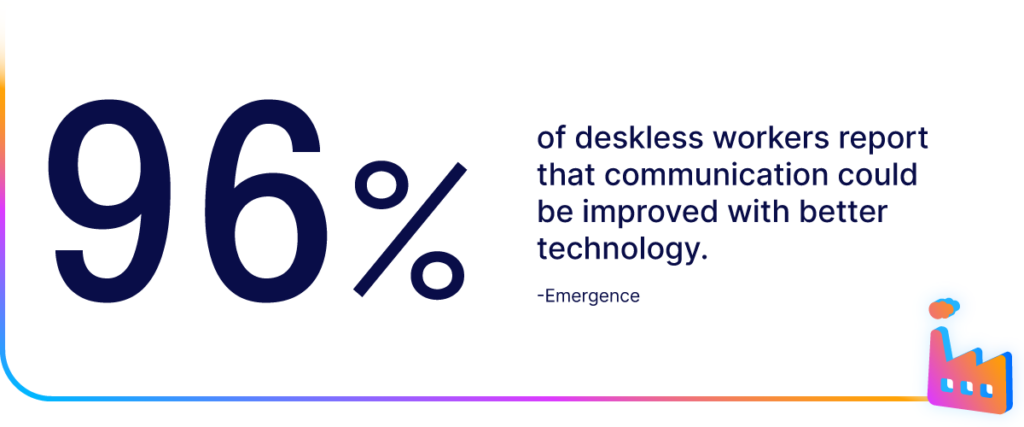
A staggering 96% of deskless workers report that communication could be improved with better technology, yet many are still reliant on bulletin boards, sporadic manager updates, or clunky kiosks.
This communication breakdown doesn’t just impact productivity — it erodes culture, trust, and engagement. Consider these realities: Only 53% of workers trust their employer. Furthermore, 60% of frontline employees feel underappreciated and disconnected from their organization.
In many companies, employee surveys see low participation because workers don’t believe their voices matter. In fact, according to PwC, just 58% of manufacturers carry out an employment engagement and culture survey and, for those that do, four in ten say that no more than half (or less) of their frontline workers actually participate in them.
When communication feels irrelevant, outdated, or inaccessible, employees check out. Disengagement becomes the silent cost of inaction, contributing to higher turnover, lower productivity, and strained labor relations.
The opportunity for internal communication: A blueprint for change
The forces manufacturers face are undeniable: transformation, workforce challenges, safety risks, and disengagement. But while these forces threaten to disrupt progress, they also represent an opportunity.
What if communication could be the key to overcoming these challenges?
Imagine a workforce where:
Every employee — from the plant floor to the C-suite — feels informed, connected, and empowered to adapt to change.
Leaders are visible, trusted, and able to communicate with clarity and purpose.
Modern tools bridge the gap between desk and frontline workers, ensuring information flows seamlessly in real time.
Employees feel safe, valued, and engaged — becoming advocates for your organization’s success.
The blueprint for better manufacturing communication isn’t just about sending messages. It’s about building connection, trust, and resilience at every level of your organization. The next chapters of this playbook will provide the tools and steps to bring this vision to life.
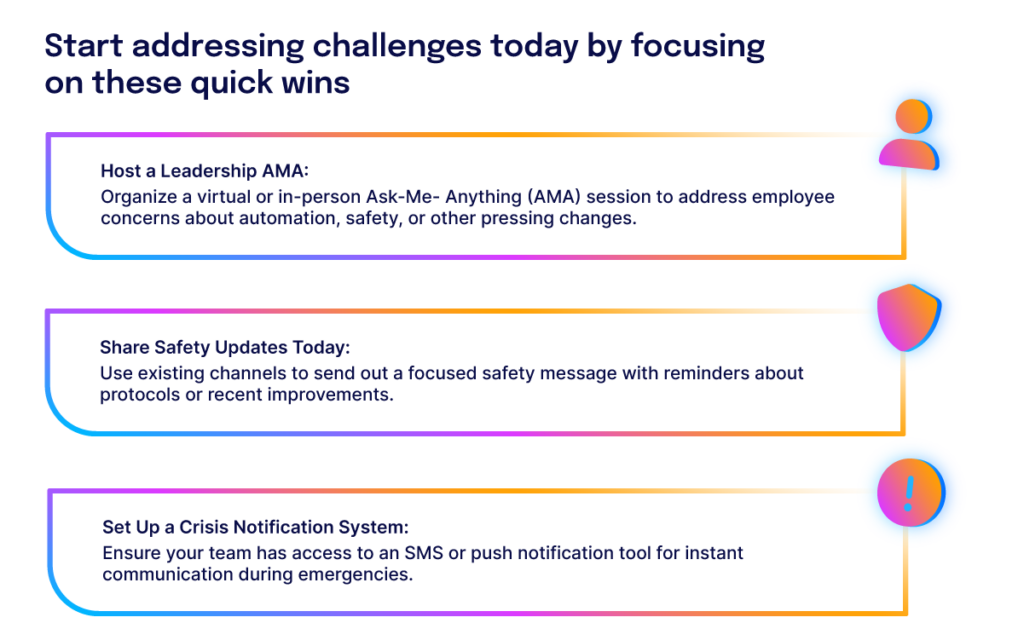
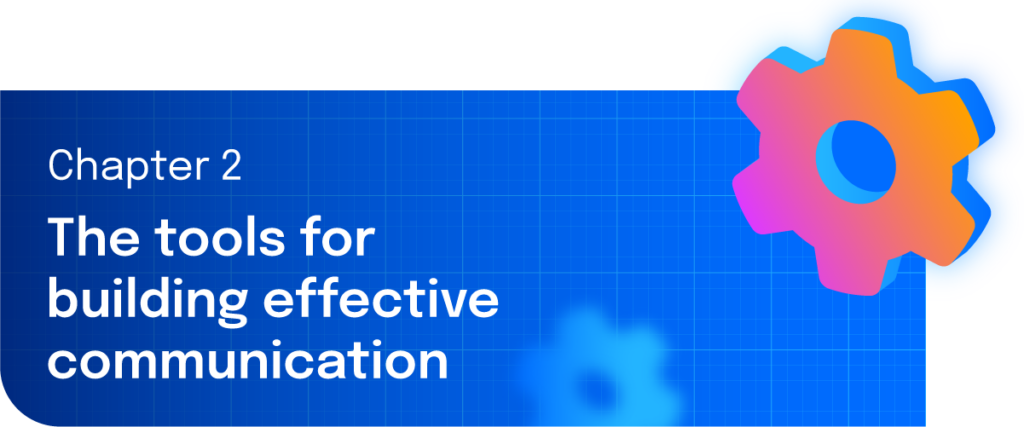
Manufacturing is a story of precision, where machines, processes, and teams work seamlessly to keep operations running smoothly — yet this level of precision often falters in internal communication, leaving messages unclear, disconnected, or irrelevant. Building a thriving, connected workforce requires a finely tuned communication strategy that starts with understanding your people, includes everyone, and modernizes how messages flow across the organization, forming the foundation of your communication blueprint.
How to equip your organization with the right tools to connect and engage
Understand your audience
In manufacturing, no two employees are the same. From assembly line workers to engineers to warehouse managers, every role has different priorities, communication needs, and access to tools. Yet many organizations treat communication as one-size-fits-all — leading to messages that miss the mark.
Understanding your audience is the first step to effective communication. By mapping out who your employees are — their roles, locations, languages, and preferences — you can tailor your approach to ensure messages resonate.
An assembly line worker with limited access to a company computer needs different communication than an operations manager who sits at a desk. Similarly, long-tenured employees may require updates framed as evolution, while new hires likely need foundational context.
 The best way to close these gaps is to listen to your employees. Use tools like surveys, focus groups, and audits to identify communication pain points and preferences. Ask questions like:
The best way to close these gaps is to listen to your employees. Use tools like surveys, focus groups, and audits to identify communication pain points and preferences. Ask questions like:
Where do you get your information today?
What tools do you need to feel more connected?
What frustrates you about how we communicate?
This level of audience insight ensures every message has the right purpose, tone, and delivery method for the people it’s meant to reach.
Think of it this way: The more you know about your workforce, the more precise and impactful your communication becomes — saving time, reducing noise, and increasing trust.
 Uncover gaps and boost engagement: Take the Ultimate Internal Comms Audit
Uncover gaps and boost engagement: Take the Ultimate Internal Comms Audit
Design an inclusive strategy
Manufacturing workplaces are diverse — spanning generations, cultures, and languages. In an industry where frontline workers often feel overlooked, inclusion must be at the core of your communication strategy. Gallup reports that just 17% of employees strongly agree that “there is open communication throughout all levels of the organization.”
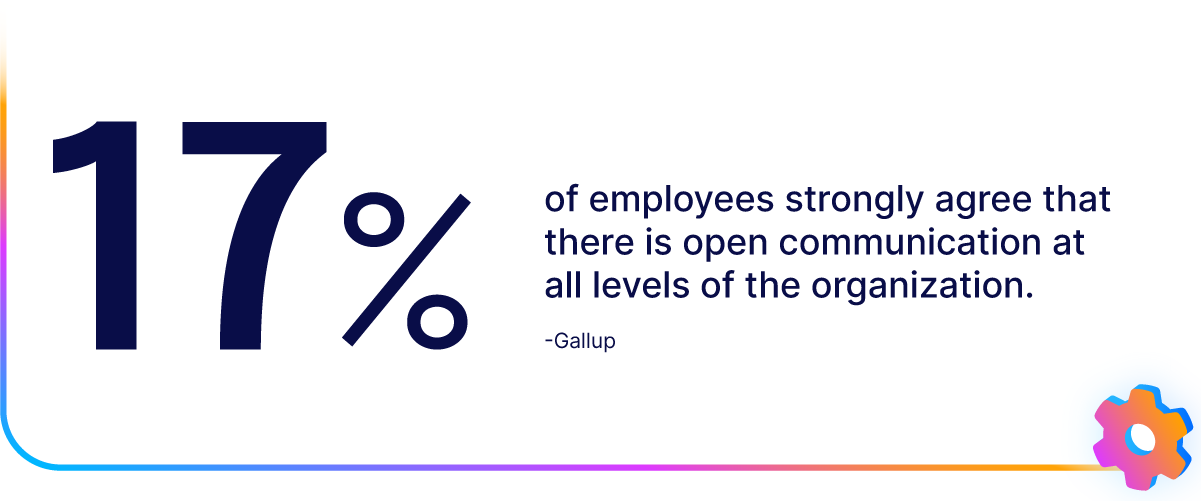 Consider the reality: many workers are non-native speakers, some employees feel more engaged through videos than written content, and younger generations prefer bite-sized, digital formats. A long-winded email might land well for a manager, but for a frontline employee, it’s just another piece of noise to be ignored.
Consider the reality: many workers are non-native speakers, some employees feel more engaged through videos than written content, and younger generations prefer bite-sized, digital formats. A long-winded email might land well for a manager, but for a frontline employee, it’s just another piece of noise to be ignored.
To reach everyone, you must meet them where they are. Design content that’s clear, concise, and accessible:
Use short-form videos or podcasts for workers on the go.
Structure written content with simple language, bullet points, and visual breaks for easy readability.
Provide translations for multilingual teams, ensuring no one feels left out of critical updates.
Inclusive strategies build bridges. They say, “We see you, we value you, and we want to communicate with you in ways that work for you.” This human-centered approach transforms communication into a tool for connection, engagement, and belonging.
The result? Messages that don’t just inform but inspire — unifying your workforce around shared goals and values.
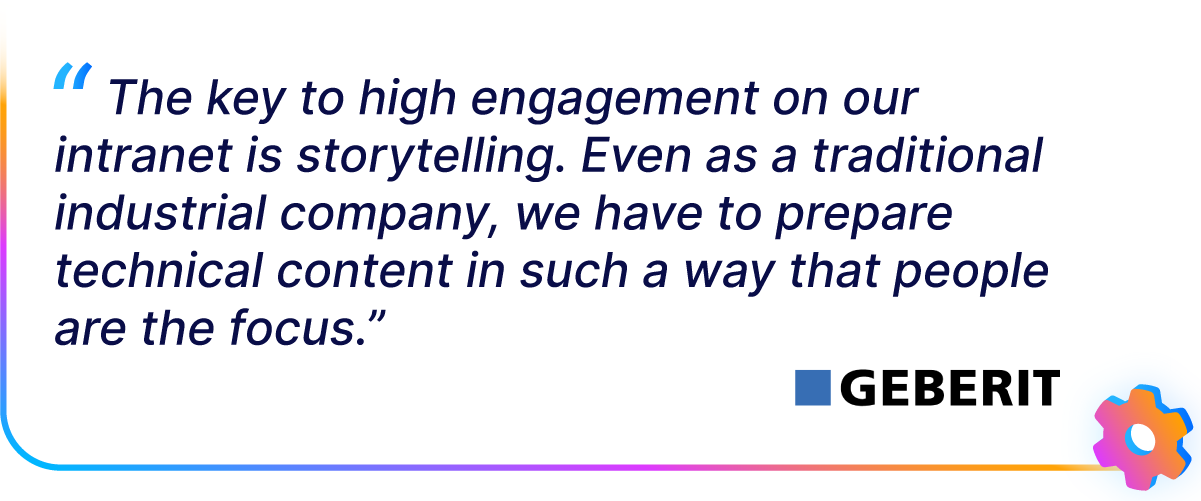
Modernize your channels
Communication tools in manufacturing often lag behind. Many organizations still rely on outdated methods like bulletin boards, kiosks, monthly newsletters, or messages passed down through manager cascades. These approaches are slow, fragmented, and unreliable — leading to delays, confusion, and missed opportunities.
Modern communication requires modern channels. Start by developing a clear channel strategy that reduces noise and ensures messages are delivered where employees are most likely to see them:
For frontline workers: Prioritize mobile-first tools that provide access to updates, resources, and protocols on their personal devices.
On the plant floor: Use digital signage to share critical, real-time updates that keep workers informed.
For direct managers: Equip them with tools to deliver team-specific updates and foster connections between desk and non-desk employees — ensuring that communication reaches everyone, wherever they work.
The goal is not to add more channels but to make each one purposeful and impactful. For communicators, these channels should be easy to manage and measure in one place, ensuring clarity and consistency without added complexity.
 Plan your comms with this free Free 2025 Communication Calendar Template
Plan your comms with this free Free 2025 Communication Calendar Template
Modern channels are the key to unlocking clarity, efficiency, and connection across your workforce.
Building a foundation for success
Knowing your audience, designing inclusive communication, and modernizing your channels are not separate steps — they work together to create a seamless communication ecosystem. When you combine these tools, your messages will:
Reach every employee, regardless of role, location, or device.
Resonate with workers in ways that are clear, engaging, and meaningful.
Reduce noise and build trust by delivering the right messages, through the right channels, at the right time.
This is the blueprint for manufacturing communication success — where every worker feels seen, heard, and connected to your organization’s goals. In the next chapter, we’ll look at the practical ways you can align leadership, empower managers, and drive trust.
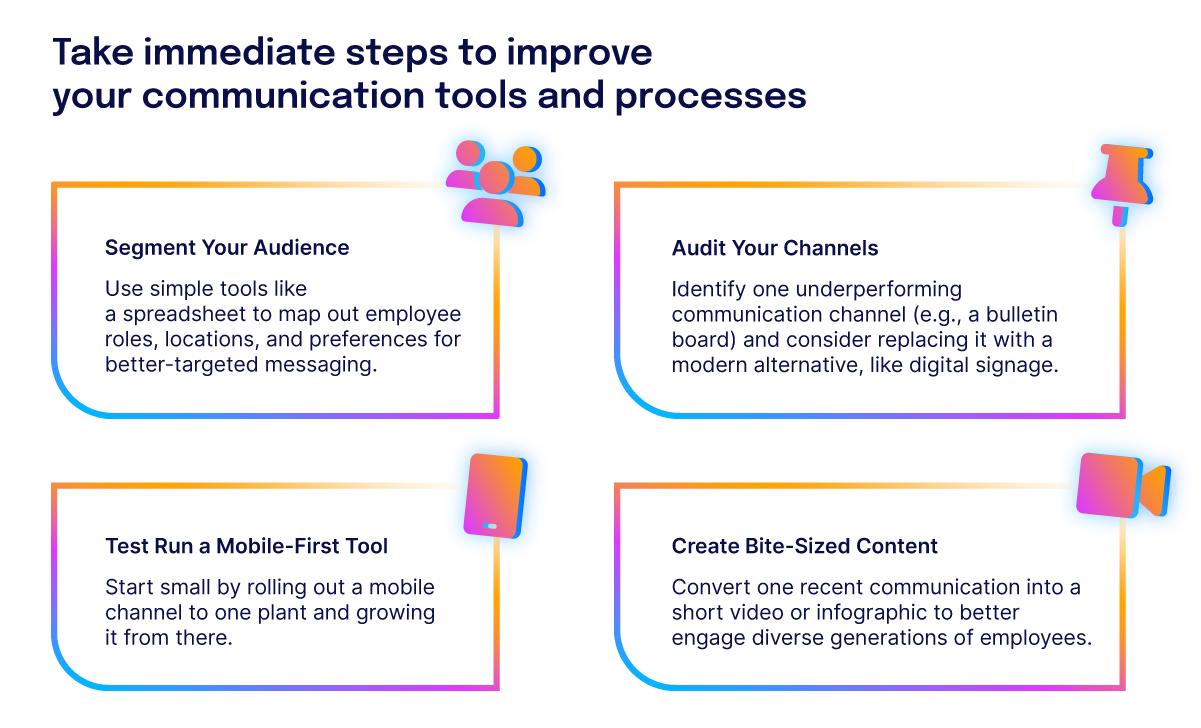

Step 1: Promote leadership visibility and trust
In any organization, leadership sets the tone. For manufacturing employees — who often feel far removed from executives — visibility is critical. Workers want to see and hear from their leaders, especially during times of change, uncertainty, or growth. Yet many leaders underestimate their role in communication or assume that cascading messages through managers is enough.
It’s not.
According to PROSCI, 61% of employees prefer hearing business updates directly from senior leaders. Why? Because visible leadership builds trust. When leaders communicate frequently, transparently, and authentically, employees feel connected to the company’s mission and confident about its direction.
If the employees who are closest to customers and who operate processes that create value are unaware of the strategy, they surely cannot help the organization implement it effectively
So, how can leaders step out of the shadows?
Host regular town halls or AMAs to address employee questions.
Use short video updates to share strategy and success stories.
Create two-way communication channels for employee feedback.
Visibility isn’t just about being seen; it’s about being available. Leaders who show up — who communicate with clarity and humility — earn trust, inspire confidence, and bridge the gap between the factory floor and the boardroom.
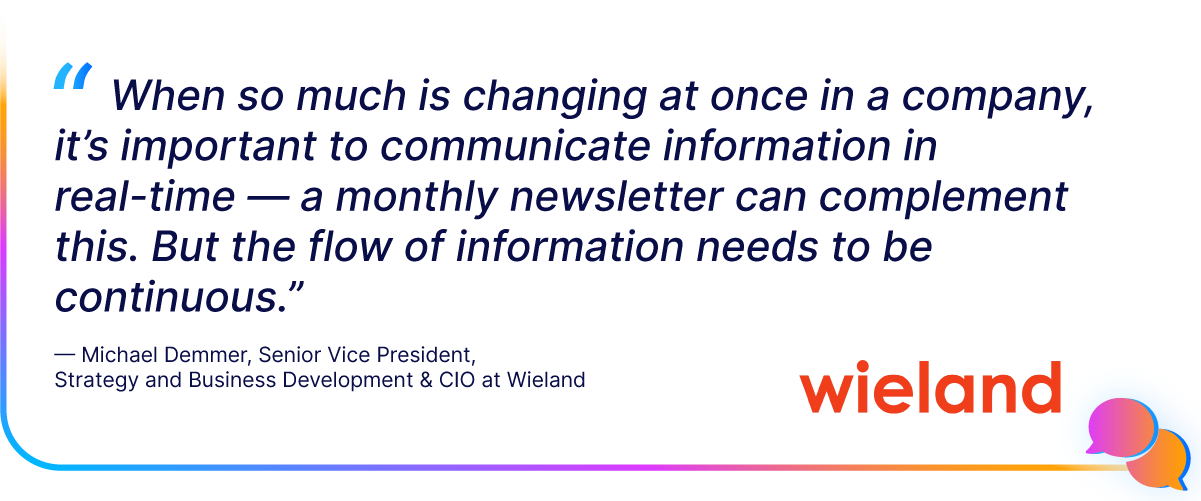
Step 2: Prioritize the digital experience for frontline employees
Frontline employees are the backbone of many organizations, yet they’re often underserved by traditional communication tools designed for desk workers. These employees need intuitive, mobile-friendly tools that keep them connected, informed, and engaged — no matter where they are.
When communication tools aren’t tailored to their needs, frontline employees are left out of critical updates, leading to confusion and disengagement. Empowering frontline workers with direct access to information ensures they know the plan, understand their role, and feel supported in their work. The result is a more cohesive, productive, and motivated workforce.
Research from PwC highlights what matters most to frontline workers:
Instilling purpose (86%): Understanding how their work supports the company’s mission.
Recognition (78%): Acknowledging accomplishments to build loyalty.
Fostering personal growth (68%): Opportunities for development drive satisfaction.
By addressing these factors, organizations can create meaningful, engaging communication that bridges global strategies with local realities.
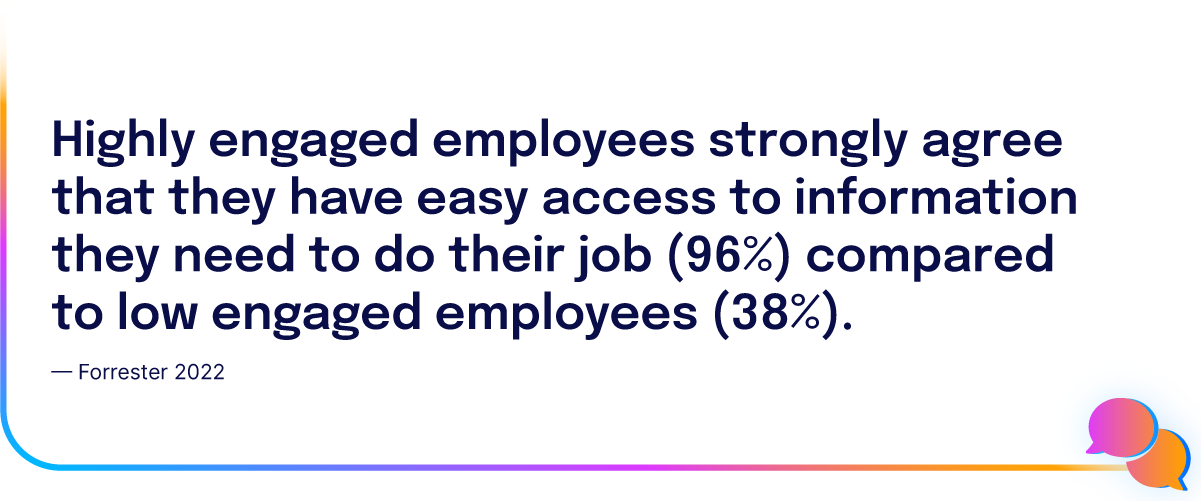 While empowering frontline employees is critical, the managers who lead these teams play a pivotal role in driving engagement and fostering connection.
While empowering frontline employees is critical, the managers who lead these teams play a pivotal role in driving engagement and fostering connection.
Frontline Managers: Bridging the communication gap
Frontline managers have unique needs as both communicators and culture champions. Equipping them with the right tools and training allows them to connect employees with the company’s mission and reinforce priorities effectively.
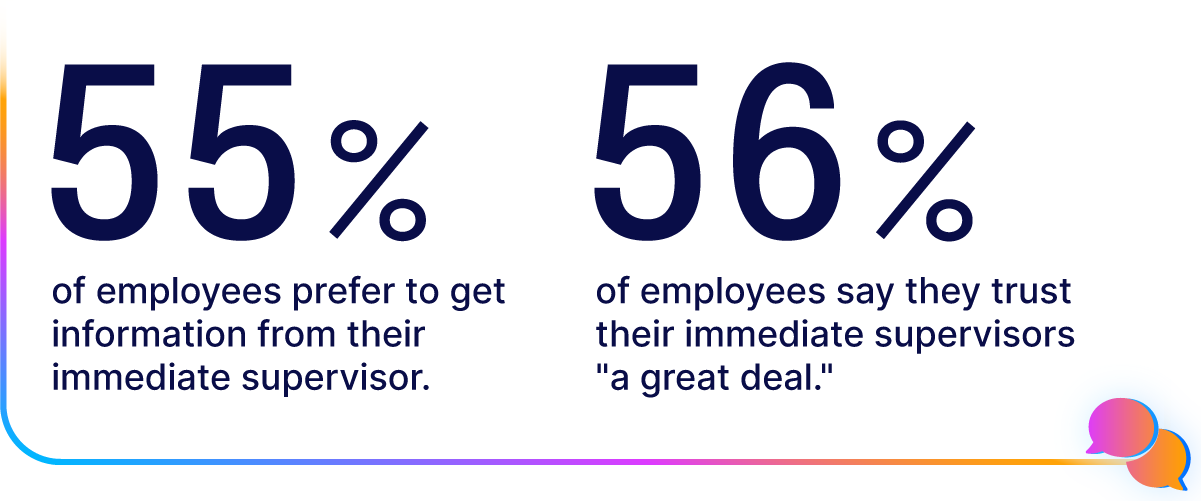 Source: “The Employee Communication Impact Report 2024,” USC Annenberg and Staffbase
Source: “The Employee Communication Impact Report 2024,” USC Annenberg and Staffbase
Here’s how to empower managers:
Provide mobile-first tools, like an employee app, to communicate updates clearly and consistently.
Train managers to deliver messages with confidence and clarity.
Reduce reliance on manual cascades by enabling direct communication from managers to employees.
At Seaboard Triumph Foods, empowering managers to highlight employee support programs drove measurable increases in engagement. When frontline managers are equipped to communicate, they become a powerful bridge between leadership strategy and employee action.
Frontline managers aren’t just intermediaries — they’re champions of connection. By empowering them to communicate with clarity and confidence, organizations can transform local teams into engaged, high-performing communities aligned with global goals.
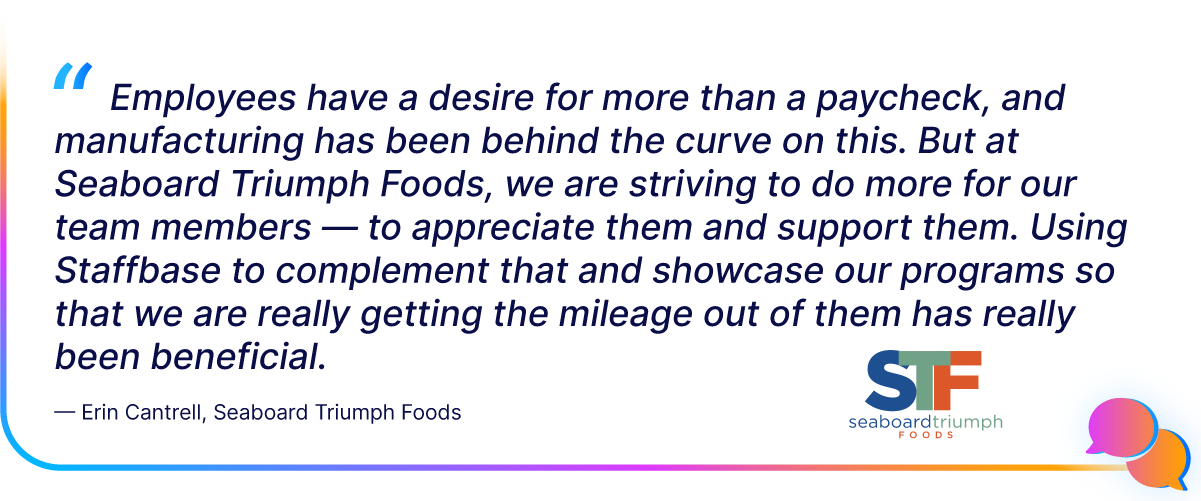
Step 3: Streamline onboarding and embed culture from day one
First impressions matter. For manufacturing companies, the onboarding process is a make-or-break moment for new employees. Done well, onboarding sets the stage for long-term success, helping workers feel connected, confident, and aligned with the company’s mission. Done poorly, it fuels turnover, disengagement, and wasted resources.
The numbers tell the story: 68% of turnover in manufacturing happens within the first 90 days, according to UKG. That’s three months of opportunity to either connect employees to the culture — or lose them entirely. And consider how that latter outcome can add up. In the US, the average cost to replace one skilled frontline worker ranges anywhere from $10,000 to $40,000.
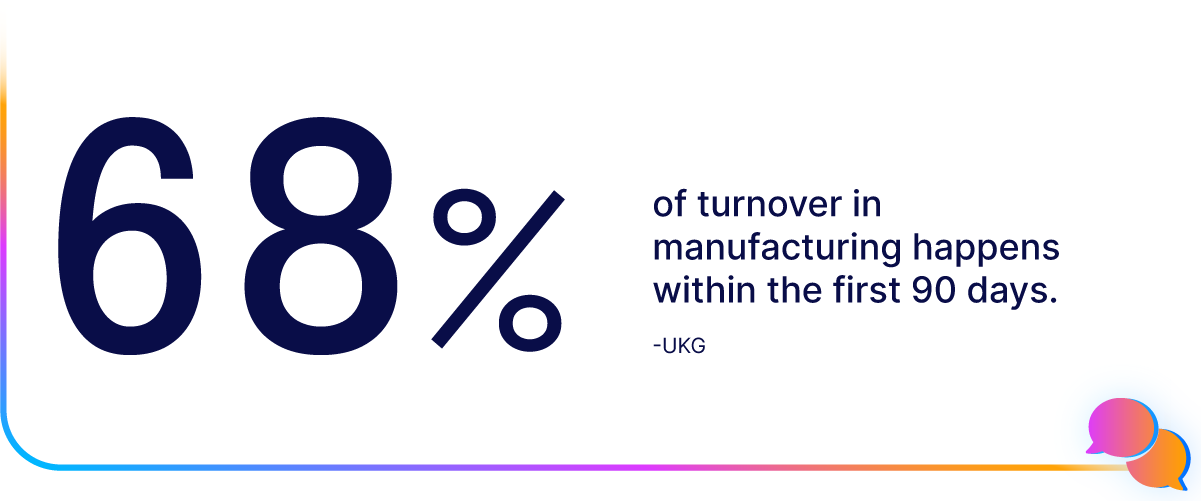
Traditional onboarding often focuses too heavily on processes and paperwork, leaving employees feeling overwhelmed, undervalued, and uninspired. Instead, onboarding should focus on both equipping employees for success and connecting them to the company’s story.
(click here for the full video)
Here’s how to streamline the process:
Automate onboarding workflows to provide timely, bite-sized access to critical resources like safety protocols, schedules, and HR tools.
Integrate culture-building messages throughout the process. Help employees understand the company’s values, purpose, and their unique role in the big picture.
Use digital tools to ensure new hires feel supported from day one, with opportunities to give feedback and ask questions.
A well-designed onboarding process quickly transforms new employees into confident, engaged team members. It also sends a clear message: We value you, and we’re invested in your success.
Step 4: Create global connection and local relevance
Many manufacturers operate on a global scale, with teams spanning continents, cultures, and languages. While this interconnectedness drives innovation, it also poses a challenge: how do you align everyone with the company’s overarching goals while addressing local needs?
The key is fostering global connection with local relevance. Employees need to feel part of a unified brand while understanding their specific role in the company’s success. At the same time, communication must resonate locally, reflecting values, cultures, and priorities.
To strike this balance, we see this work with lots of manufacturing organizations:
Create a local content strategy
Move away from top-down communication structures and enable local leaders to tailor messages to their teams.
Equip non-communications leaders, like supervisors and managers, with the tools and training needed to deliver impactful, team-specific updates.
Build authentic communities
Strengthen connections on the ground by fostering grassroots communities that align with both company values and local priorities.
Identify local influencers or champions who can advocate for the brand, share stories, and drive engagement.
Leverage multilingual and accessible tools
Use translation tools to deliver company-wide updates in multiple languages, ensuring no one is left out.
Incorporate AI-supported content to create a conversational tone that feels personal and accessible — especially for frontline workers who may find traditional corporate messaging distant or irrelevant.
Some real-world examples of globally connected organizations
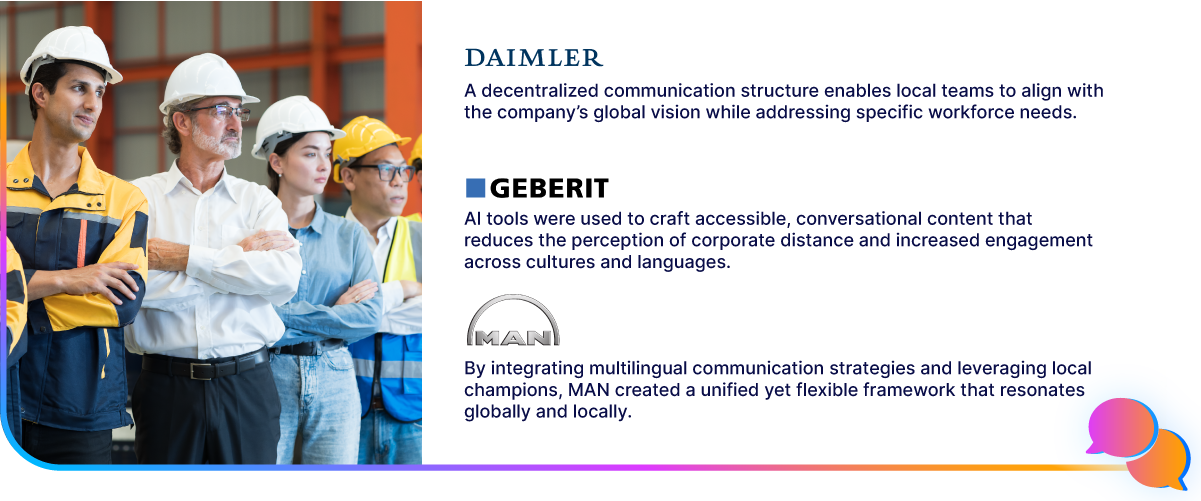
The impact of localized communication
Research from BCG shows that the benefits of connecting employees globally while empowering them locally are profound:
Higher Productivity: Employees with higher satisfaction demonstrate a 17% increase in productivity.
Reduced Turnover: A 25% decrease in turnover can be achieved by improving communication and creating meaningful engagement.
Improved Attendance: Satisfied employees report a 41% reduction in absenteeism.
When employees feel aligned with the global mission but connected to their local teams, the result is a workforce that is engaged, loyal, and ready to contribute to the company’s success.
Step 5: Connect employees across language and culture
In manufacturing, diverse cultural and linguistic backgrounds drive innovation but also create communication challenges. How can every worker feel informed and connected, regardless of their language or culture?
The solution lies in multilingual, culturally nuanced communication. It’s not just about translations — messages must resonate with employees’ contexts and experiences. Modern tools, like AI-driven content creation, make this possible by delivering timely, conversational updates that feel relevant and human.
By bridging language and cultural barriers, organizations foster trust, collaboration, and belonging, ensuring every employee feels valued.
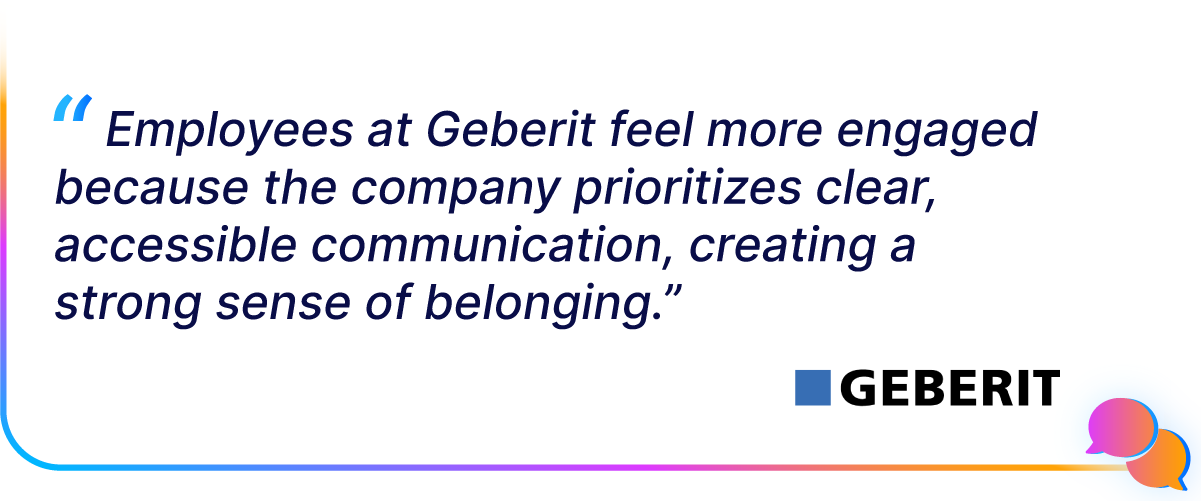
Step 6: Prepare for crisis communication
In manufacturing, crises are not a question of if — they’re a question of when. Whether it’s a safety incident, equipment failure, cyberattack, or natural disaster, disruption can strike at any moment. In these critical times, communication is the difference between chaos and control.
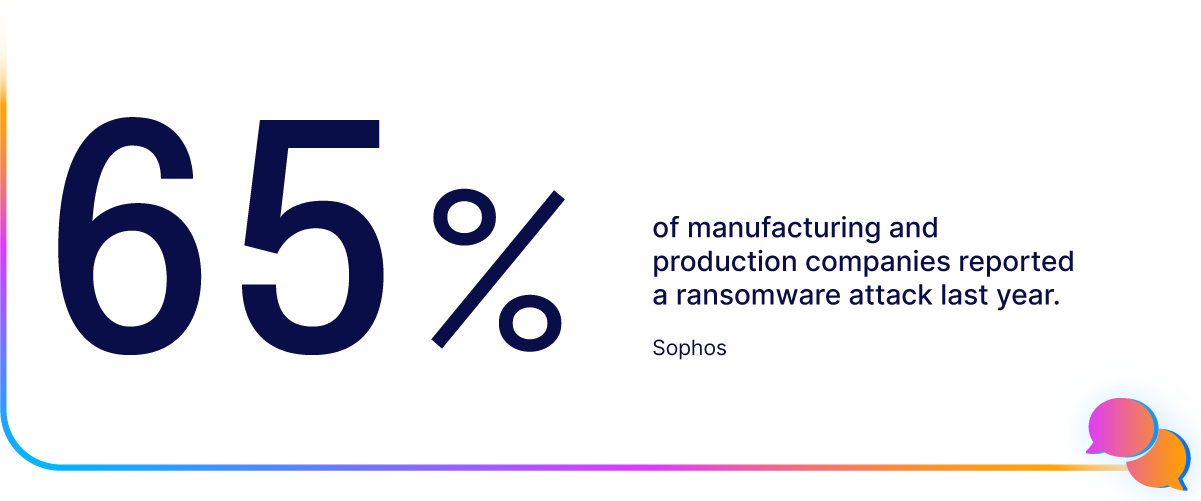 Nearly two-thirds (65%) of manufacturing and production companies reported a ransomware attack during the past year. Sophos
Nearly two-thirds (65%) of manufacturing and production companies reported a ransomware attack during the past year. Sophos
Employees need clear, timely, and actionable information to respond effectively during a crisis. Delays or unclear messages erode trust and put both workers and operations at risk. For manufacturing leaders, the goal is simple: ensure everyone knows what to do and where to go when disruptions occur.
A strong crisis communication plan includes:
Instant-reach tools like push notifications or SMS to quickly alert employees of safety updates, operational changes, or critical protocols. Acknowledgement buttons allow you to make sure employees read about any new safety protocols.
Easily accessible safety resources — stored on mobile apps rather than buried in outdated binders or kiosks.
A clear, centralized crisis communication plan that empowers leaders and managers to communicate quickly, accurately, and consistently.
During a crisis, speed matters. Manufacturing teams that can communicate clearly in high-stakes moments will not only mitigate risks but also reinforce trust and confidence among employees.
Read the blog post: The Ultimate Guide to Crisis Communication
A framework for success
Promoting leadership visibility, empowering frontline managers, streamlining onboarding, and preparing for crises aren’t standalone actions — they are the pillars of a resilient communication framework. Together, these steps create an ecosystem where:
Leaders earn trust through transparency and connection.
Managers become champions of clarity, culture, and engagement.
New employees feel valued and aligned from day one.
Teams respond effectively and confidently when disruptions arise.
Communication isn’t just a tool — it’s the foundation for a stronger, more connected workforce. By building this framework, manufacturing organizations can navigate challenges, build trust, and empower their people to thrive.
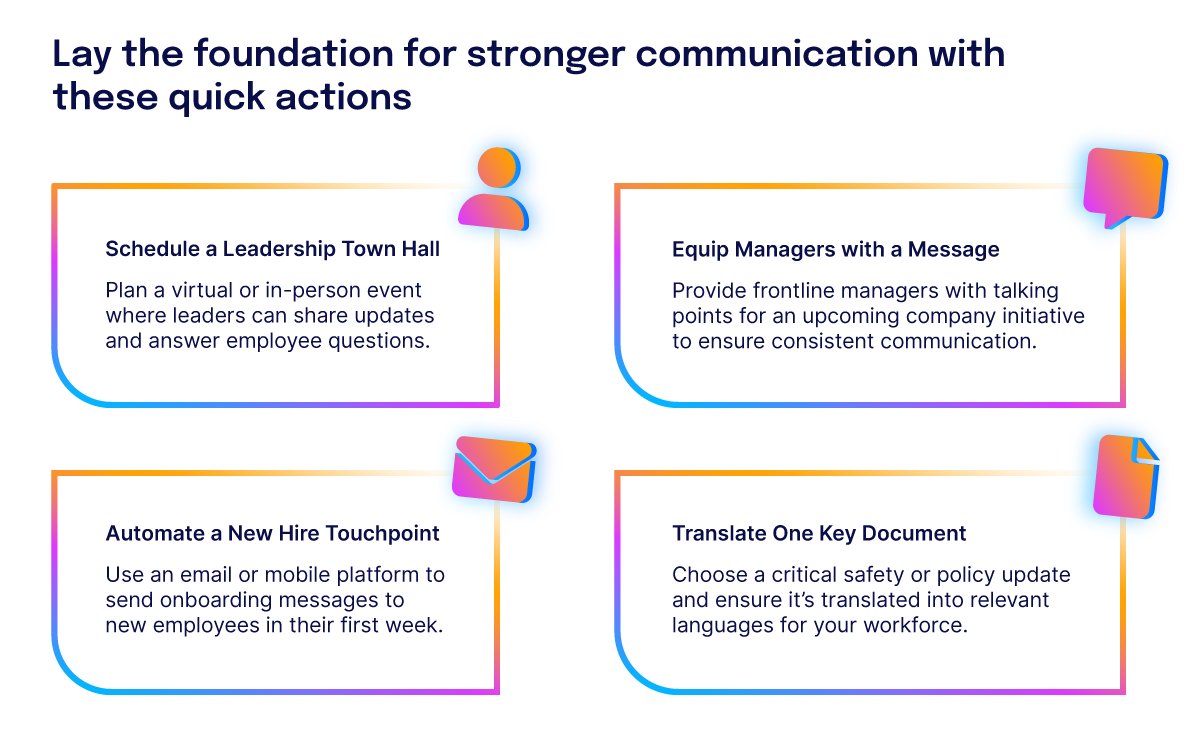

You’ve built your communication blueprint. You’ve addressed challenges, modernized tools, empowered leaders, and connected teams. But how do you know if it’s working? How do you ensure that your communication strategy isn’t just another initiative but a driver of real, measurable outcomes?
How to know your communication framework is delivering impact
In manufacturing, success is defined by results. Machines are fine-tuned for precision, processes are measured for efficiency, and every system is optimized for maximum output. Internal communication deserves the same level of rigor. To transform communication from a series of “sent messages” into a strategic tool that delivers value, organizations need to measure what truly matters: outcomes, not outputs.
Why measurement matters
Too often, communication success is judged by surface-level metrics: the number of emails sent, posters pinned up, or meetings held.
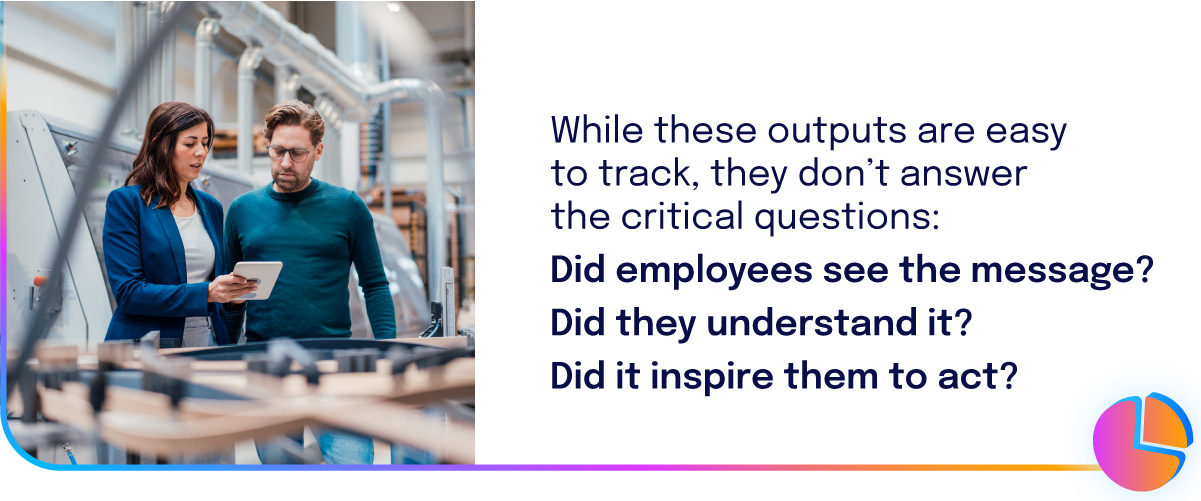
Measuring communication outcomes allows you to focus on impact. It tells you what’s resonating, what’s driving engagement, and where gaps still exist. More importantly, it connects communication to broader business goals — whether that’s reducing turnover, improving safety compliance, or fostering a stronger workplace culture.
When you know what’s working — and what isn’t — you can adjust, improve, and maximize the value of your communication efforts.
Defining success: 3 critical outcomes
To build a connected, engaged, and inspired workforce, communication success must focus on three measurable outcomes:
Outcome 1: A connected workforce
What it looks like: Employees feel informed and aligned, even during moments of disruption or crisis. They know where to get information, they trust its accuracy, and they act on it.
Key metric: Message reach and acknowledgment rates.
Why it matters: During a crisis — whether it’s a cyberattack, safety incident, or weather emergency — every minute counts. Ensuring employees receive timely, clear updates can mean the difference between chaos and control.
Example: A manufacturing company facing an unexpected operational disruption uses mobile push notifications to alert frontline workers. Within minutes, employees receive the update, acknowledge it, and adapt their workflows — keeping safety and productivity intact.
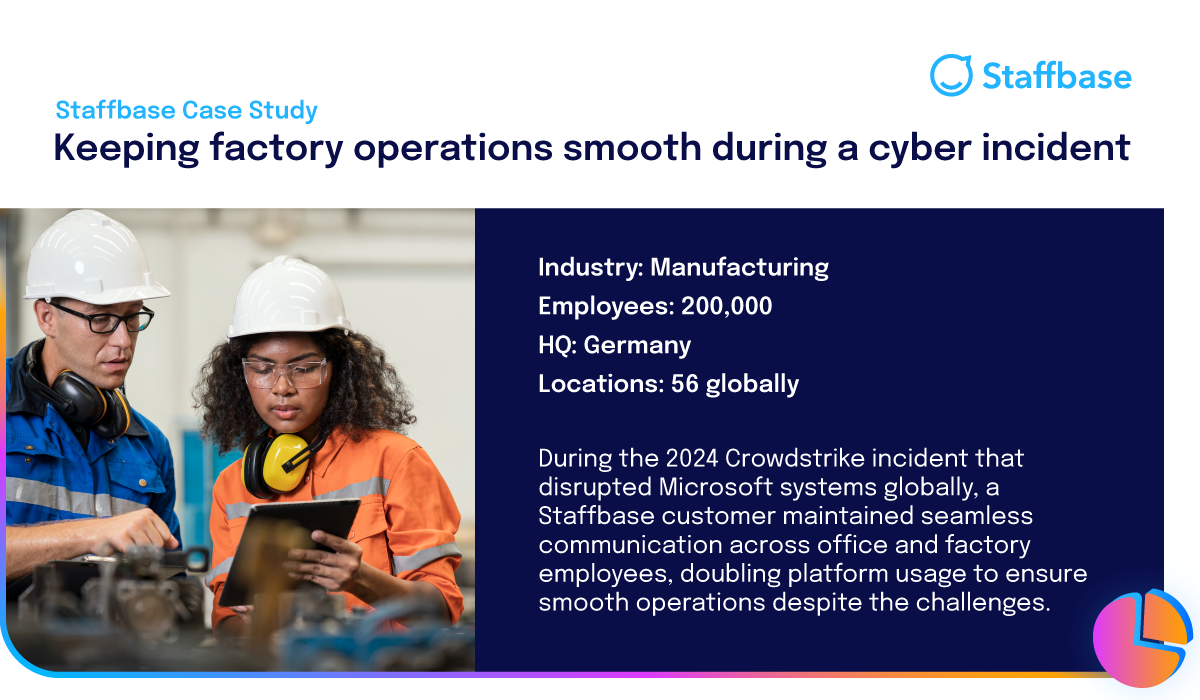
Outcome 2: Engaged employees
What it looks like: Onboarding processes reduce turnover, and employees feel connected to the company culture and purpose. Workers are invested in their roles and understand how their contributions drive success.
Key metric: Retention rates and employee sentiment scores.
Why it matters: Engagement isn’t just about satisfaction — it’s about alignment. Engaged employees stay longer, perform better, and become advocates for your company.
Example: An automated onboarding journey delivers step-by-step resources, culture messages, and support over a new hire’s first 90 days. By addressing questions early and fostering a sense of belonging, the company reduces turnover during this critical period.
Outcome 3: Inspired advocates
What it looks like: Employees don’t just understand company goals — they champion them. They speak positively about the organization, take pride in their work, and serve as ambassadors for the brand.
Key metric: Alignment scores, employee feedback, and engagement with key initiatives.
Why it matters: Employees who align with company goals drive growth, innovation, and a positive workplace culture.
Example: After rolling out a leadership visibility program — including regular video updates and town halls — employees report higher trust in leadership and alignment with company strategy. Sentiment scores reflect increased pride and motivation.
How to measure communication success
Building a measurement framework doesn’t need to be complex. Start with clear objectives tied to business goals, then track performance across three key areas:
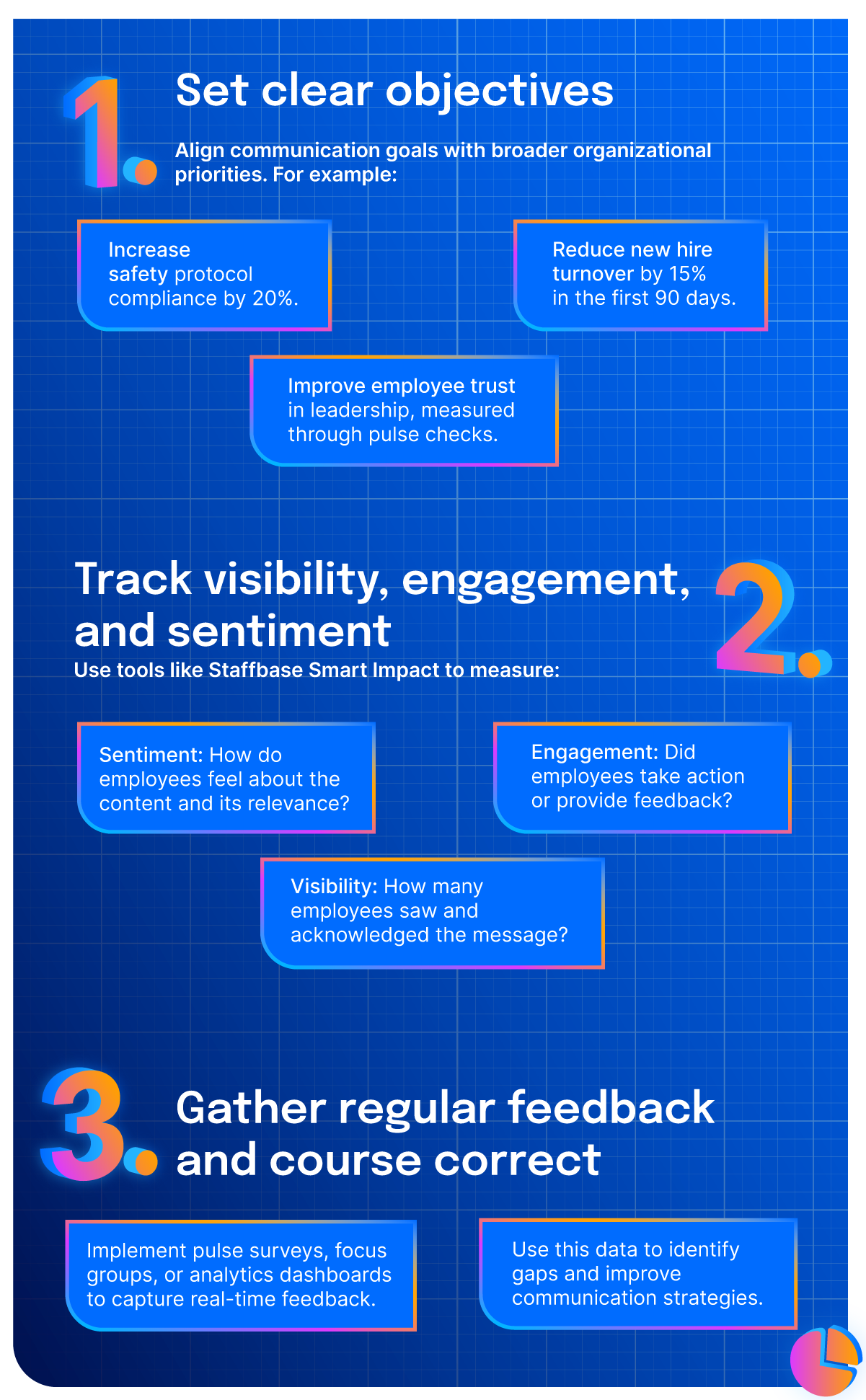
Tools like Staffbase Smart Impact provide real-time insights into communication performance, helping you track progress, measure employee sentiment and alignment, and continuously optimize your approach.
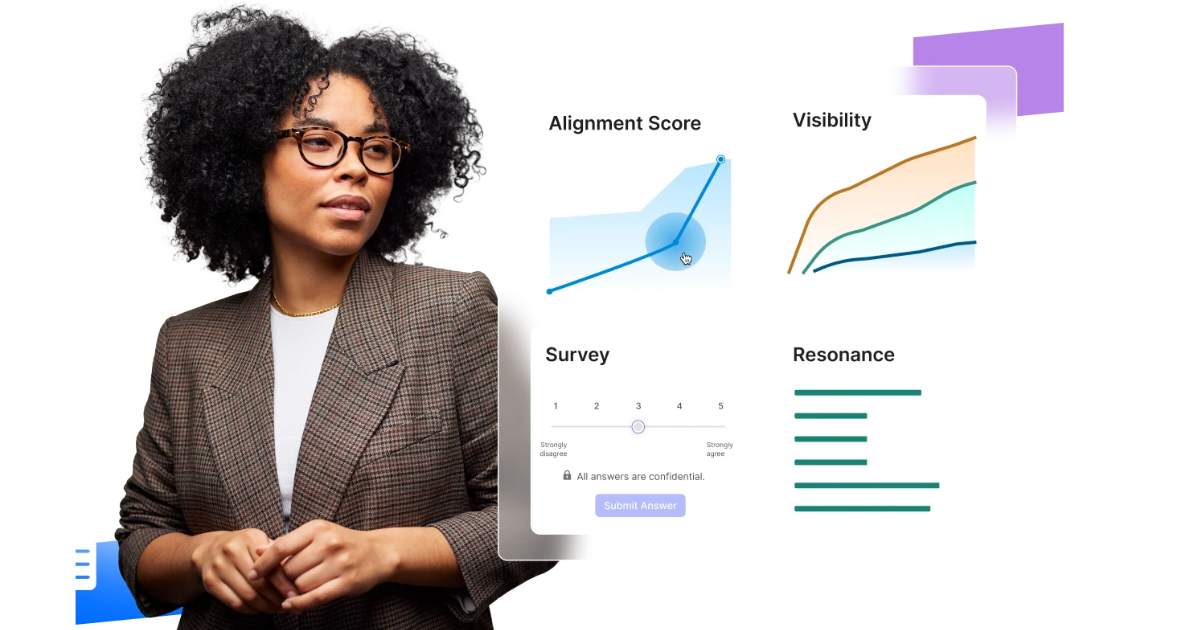 Take a closer look at Staffbase Smart Impact
Take a closer look at Staffbase Smart Impact
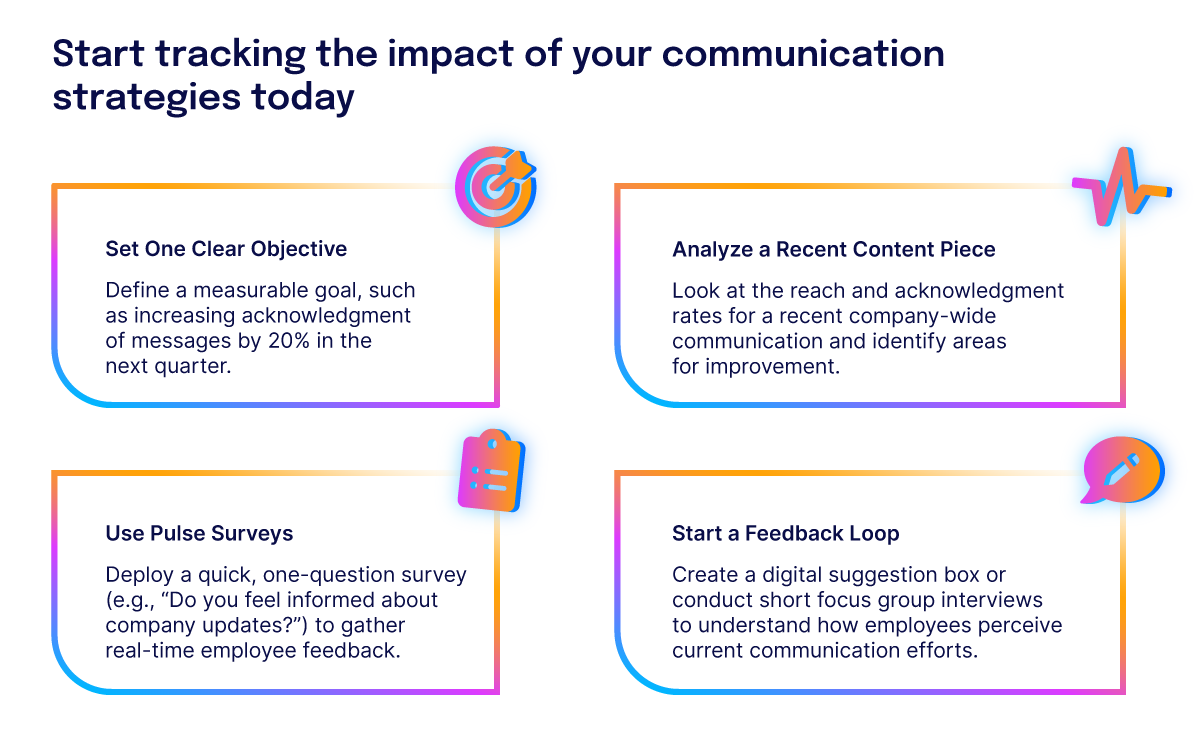

Success in manufacturing depends on a workforce that is connected, engaged, and inspired. When communication works, employees don’t just receive information — they trust it, understand it, and act on it.
This playbook has hopefully provided you with the tools, strategies, and steps to build a modern communication framework:
Understand your audience and tailor communication to their needs.
Empower leaders and managers to drive clarity and connection.
Streamline processes like onboarding to boost retention and belonging.
Prepare for crises with fast, reliable communication tools.
Measure outcomes to ensure your efforts deliver real impact.
With this blueprint, you’re not just sending messages — you’re building a foundation for success, one that connects every employee to your company’s mission, values, and future.
Ready to take the next step in building up your communications?

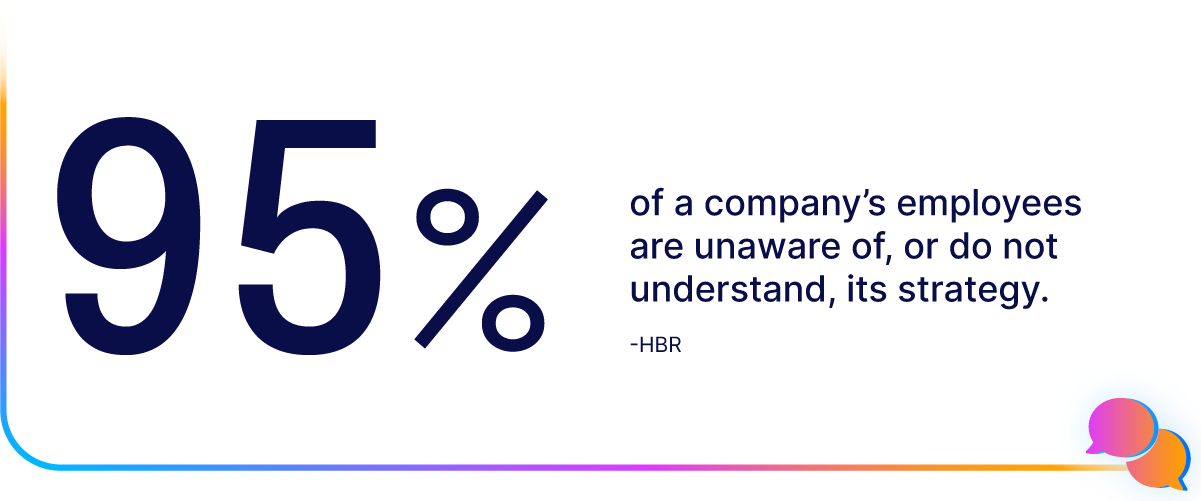 Source:
Source: 

